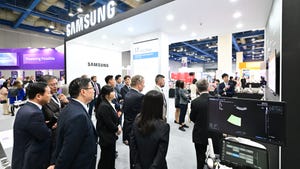Alcatel Holds World Record for a Day
... then along comes NEC with an even bigger claim for high-capacity transmission
March 22, 2001

ANAHEIM, Calif. -- OFC2001 -- Yesterday Alcatel SA (NYSE: ALA; Paris: CGEP:PA) claimed that it had set two new world records for the amount of data to be carried on a single fiber (see Alcatel Claims World Records).
In the first experiment, it sent 10.2 Tbit/s of data -- comprised of 256 channels, each at 42.7 Gbit/s -- over 100 kilometers of TeraLight fiber. Alcatel managed to double its previous best, set in September 2000, by using polarization multiplexing (see Alcatel Claims DWDM Speed Record). In fact, the company claimed it's the highest aggregate capacity transmission ever, full stop.
In the second experiment, Alcatel managed to send 3 Tbit/s over 7,380km. This was composed of 300 channels at 11.6 Gbit/s each. It's the highest capacity to be sent over transoceanic distances without electrical regeneration.
Both advances will be described in postdeadline papers to be presented at OFC here today (Thursday). But only the second of those records still holds.
In another of the postdeadline papers, scientists from NEC Corp. (Nasdaq: NIPNY) will describe how they managed to transmit nearly 11 Gbit/s of data over a distance of about 115km, using a mid-span amplifier. NEC says it set up 273 channels of 40 Gbit/s each, spaced at 50 GHz, to achieve the rate of 10.92 Tbit/s overall.
Some might see these competing claims as hair-splitting. After all, 10.2 and 10.9 Tbit/s are both very impressive capacities, and since they were accomplished with quite different approaches, both achievements enhance our knowledge of high-capacity transmission.
Alcatel makes a big deal out of breaking "the mythical 10-Tbit/s barrier." Even when bandwidth is used efficiently -- by employing 40-Gbit/s signals and 50 GHz channel spacings -- it takes more than 100 nanometers of bandwidth to achieve 10 Tbit/s. This cannot be done with just the C- and the L-bands.
There are two ways of getting around this obstacle: Expand into another band, or use trickery to increase the so-called spectral efficiency (measured in bits transmitted per Hertz of bandwidth, or bit/Hz). NEC adopted the former idea, putting additional channels into the S-band -- the region between 1480 and 1520nm. Alcatel opted for trickery.
In its 5.1-Tbit/s experiment last year, Alcatel used uneven channel spacings that alternate between 50 and 75 GHz. The basic idea of this is to reduce non-linear interactions between the channels, which create replicas of the signal at regular intervals. That's all very well, but it doesn't sound very compatible with today's components and DWDM (dense wavelength-division multiplexing) systems, which are all designed around the evenly spaced International Telecommunication Union (ITU) grid.
The use of its TeraLight fiber is also significant. TeraLight has higher dispersion than other non-zero dispersion-shifted fibers, which helps further reduce non-linear effects. Alcatel also employed forward error correction (FEC) -- 42.7 Gbit/s per channel includes the FEC overhead.
Then, as noted, everything was doubled up in the current experiment by splitting each wavelength into two polarizations and encoding them separately. While this technique may be fine in the lab, it's never been deployed in the real world.
NEC, on the other hand, had different issues to contend with. To achieve the same 100km distance, it needed amplification in the middle of the span. For this it used a thulium-doped fiber amplifier in combination with Raman pumping. So now three amplifiers are required at the amplification point, one for each of the S-, C-, and L-bands.
The other issue that NEC had to deal with is that ordinary transmission fibers aren't designed to work in the S-band. The point of zero dispersion -- at which non-linear effects are most pronounced -- lies in the S-band. So NEC used a pure silica core fiber and reverse dispersion fiber in the span -- not something that's deployed in everyday networks. Ironically, Alcatel's TeraLight fiber is designed to work right across the S-band.
This analysis shows both of these results for what they are -- hero experiments that aren't designed for the real world. Milorad Cvijetic, chief technology strategist of NEC's transport products division, agrees.
"There's a world of difference between what you can do in the lab and what the real world requires," he says. Other important real-world issues, such as consistent power budgeting and supervisory control, don't have to be dealt with in the lab either, he adds.
— Pauline Rigby, senior editor, Light Reading, http://www.lightreading.com
You May Also Like










